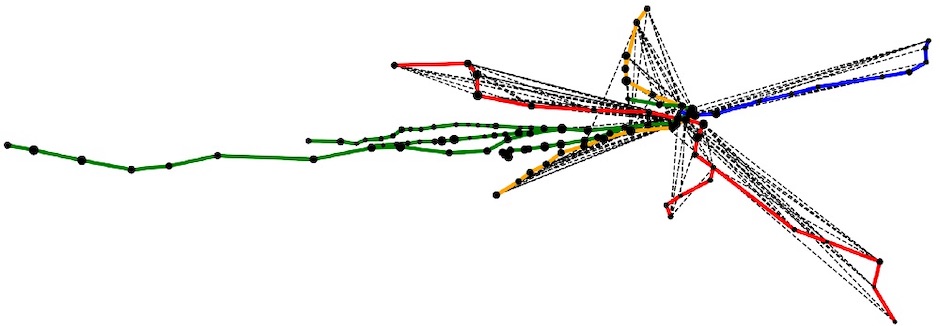Schlangenfraß: Eine riesige Python-Linkschleuder
Es ist mal wieder ein Ausmisten meines Feedreaders fällig gewesen. Und so gibt es heute eine Riesenlinkschleuder zu Python mit einem Schwerpunkt auf Data Science, Neuronale Netze, Natural Language Processing, Jupyter, Visualisierung und Web Scraping. Aber auch einige andere Themen sollen nicht zu kurz kommen.
Visualisierung
-
Will Koehrsen: The Next Level of Data Visualization in Python. How to make great-looking, fully-interactive plots with a single line of Python.
-
Noch einmal Will Koehrsen: Introduction to Interactive Time Series Visualizations with Plotly in Python. Up and running with the powerful plotly visualization library.
-
Jeremy Miller: Interactive Histograms with Bokeh.
-
Sam Wilkinson: Progress Bars in Python.
-
Sammy Lee: Visualizing The Madness of Crowds with Python.
-
Amy Vogel: I built the T with Python (and revamped it). Python is a great tool for modeling networks — so what can it tell us about how to improve the T?
-
Cole Pacak: Visualizing Recessions with Pandas and Three.js. Look Ma, pandas! 🐼
-
Maarten Breddels: Vaex: Out of Core Dataframes for Python and Fast Visualization. Look Ma, no pandas. 🐼
Pandas
-
Wesley Goi: Tidying Up Pandas.
-
Was ist Geopandas? Michel Kana weiß es: Mapping Inequality in Peer-2-Peer Lending using Geopandas — Part 1.
Jupyter
-
Matthias Parbel: RStudio Connect 1.7.0 beherrscht auch Python und Jupyter Notebooks. Data Scientists können die Veröffentlichungsplattform nun auch zur Veröffentlichung von Inhalten aus Python und Jupyter Notebooks einsetzen. Hier wächst zusammen, was zusammen gehört.
-
Martin Renou: A new Python kernel for Jupyter.
-
Lorena A Barba: Teaching and Learning with Jupyter.
-
Parul Pandey: Bringing the best out of Jupyter Notebooks for Data Science. Enhance Jupyter Notebook’s productivity with these Tips & Tricks.
Natural Language Processing (NLP)
-
*Matthias Parbel: Facebook gibt NLP-Library PyText als Open Source frei. PyText baut auf dem ML-Framework PyTorch auf und kam bisher nur intern bei Facebook für Natural Language Processing (NLP) zum Einsatz.
-
Jesus Rodriguez: Introducing PyText, Facebook’s New Framework for Better NLP Development.
-
Susan Li: Develop a NLP Model in Python & Deploy It with Flask, Step by Step. Flask API, Document Classification, Spam Filter.
-
Derek Chia An implementation guide to Word2Vec using NumPy and Google Sheets. Learn the inner workings of Word2Vec.
-
Félix Revert: An overview of topics extraction in Python with LDA. Using LDA (Latent Dirichlet Allocation) for topics extraction from a corpus of documents
Neuronale Netze
-
Suraj Donthi: Neural Networks with Numpy for Absolute Beginners: Introduction. In this tutorial, you will get a brief understanding of what Neural Networks are and how they have been developed. In the end, you will gain a brief intuition as to how the network learns.
-
Dalya Gartzman: Neural networks for dummies: a quick intro to this fascinating field.
Web Scraping
-
Jonathan Oheix: An introduction to web scraping with Python. Let’s scrape a fictional book store’s website with BeautifulSoup!
-
Gilbert Tanner: Introduction to Web Scraping with BeautifulSoup. How to use web scraping to get information from a Wikipedia page.
-
Vijay athithya: Can python be used for Facebook chat backup? of course, it can!. Simple Walkthrough on Web Scraping and Scrapy Framework.
Sonstige interessante Beiträge
-
Genevieve Hayes: Solving Travelling Salesperson Problems with Python. How to use randomized optimization algorithms to solve travelling salesperson problems with Python’s mlrose package.
-
Neil Kakkar: How not to be afraid of Python anymore. A dive into the language reference documentation.
-
Ben Weber: A Brief Introduction to PySpark. A primer on PySpark for data science.
-
Parul Pandey: Music Genre Classification with Python. A Guide to analysing Audio/Music signals in Python.
War sonst noch was? Ach ja, die Python-Bibliothek NumPy ist in Version 1.16 erschienen. Mit der neuen Version liegt das letzte NumPy-Release vor, das die Programmiersprache Python in Version 2.7 unterstützt. Außerdem hinaus ist der Support für Python 3.4 weggefallen, NumPy 1.16 unterstützt nur noch die Versionen 2.7, 3.5, 3.6 und 3.7. Wer für die nächste Zeit allerdings weiter auf Python 2.7 setzen möchte, kann noch eine Weile unbesorgt bleiben: NumPy 1.17 ist ein Long Term Release und das Team wird Bugfixes bis 2020 liefern. Ähnliches bei Everett, der Konfigurationsbibliothek für Python Apps: Sie erreicht nach fast 2,5 Jahren die Version 1.0.0, unterstützt jetzt Python 3.7, aber nicht mehr 3.3 und 2.7. Ich bin nicht glücklich darüber, denn Nodebox 1 läuft nur mit Python 2.7 und ich möchte das Teil eigentlich noch länger nutzen. Everett ist mir egal, aber NumPy brauche ich!
Über …
Der Schockwellenreiter ist seit dem 24. April 2000 das Weblog digitale Kritzelheft von Jörg Kantel (Neuköllner, EDV-Leiter, Autor, Netzaktivist und Hundesportler — Reihenfolge rein zufällig). Hier steht, was mir gefällt. Wem es nicht gefällt, der braucht ja nicht mitzulesen. Wer aber mitliest, ist herzlich willkommen und eingeladen, mitzudiskutieren!
Alle eigenen Inhalte des Schockwellenreiters stehen unter einer Creative-Commons-Lizenz, jedoch können fremde Inhalte (speziell Videos, Photos und sonstige Bilder) unter einer anderen Lizenz stehen.
Der Besuch dieser Webseite wird aktuell von der Piwik Webanalyse erfaßt. Hier können Sie der Erfassung widersprechen.
Diese Seite verwendet keine Cookies. Warum auch? Was allerdings die iframes von Amazon, YouTube und Co. machen, entzieht sich meiner Kenntnis.
Werbung

